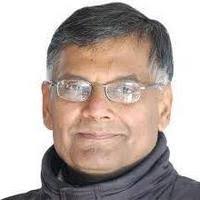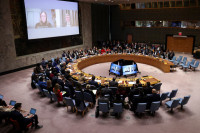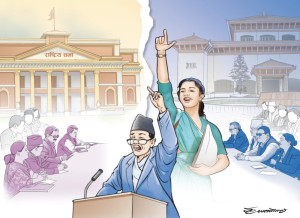Columns
Six years of ethnonational upsurge
Khas-Arya supremacists consider the Divya Upadesh to be the manual of nationalism.
CK Lal
In an evocative coincidence, the Indra Jatra festival and the Constitution Day celebrations fall on the same date—September 19—this year. After September 25, 1768, the chariot festival had begun to signify the Gorkhali conquest while the celebration of the charter since 2015 has come to connote the consolidation of the victorious community's dominance over the polity of the country. It was during the Indra Jatra festivities, when King Jaya Prakash Malla was pulling the chariot of the living goddess, that the Gorkhali ruler attacked by stealth and captured the principal Malla kingdom of Nepal Valley. The conqueror then appropriated the crown, and allowed the procession to proceed with its sacred routine. In an exercise of renewing divine legitimisation, the Shah dynasty continued to patronise the ritual and turned the event into a substitute for the annual victory parade.
The controversial charter was fast-tracked in the immediate aftermath of the cataclysmic Gorkha earthquake. No discussion was held in public over its provisions. Fearing dissension in their ranks, the dominant parties had issued party whips to ensure its hasty endorsement. The contentious constitution received contradictory responses from the people. The constitutionally created ethnonationals of the Khas-Arya community lit lamps to mark the institutionalisation of their primacy. Most Madhesis observed a voluntary blackout to mourn the loss of their dignity. For a significant section of ethnic minorities in the country, it became a day that once again legitimised the Gorkhali hegemony.
Republican leaders since May 2008 have maintained the tradition of the Shah dynasty, and continue to receive blessings from the living goddess Kumari. The charter day is the constitutional version of the Khas-Arya victory celebrations. Even though many Madhesi politicos have submitted to the power of the supreme law and accepted various official positions with the responsibility of enforcing it, the process of its formulation continue to rankle families in Madhes that lost their loved ones in the Third Madhes Uprising.
Ideological confusion
Once the Gorkhali conqueror had succeeded in subjugating the entire Nepal Valley, he concentrated on extending its boundary eastwards and consolidating the hold of his loyalists over the annexed territories. Before his death, he is believed to have delivered the Divya Upadesh—meaning divine counsel, no less—which the Khas-Arya supremacists consider to be the manual of nationalism to this day. The Divya Upadesh became the royal charter of "constituting" the Gorkhali nation.
When Jung Bahadur Rana managed to eliminate the entire Gorkhali nobility on September 14, 1846 in the Kot Massacre, he made no bones about declaring that his word was law. The post-facto legitimatisation of the usurper was achieved almost a decade later with the promulgation of the Muluki Ain in 1854 that codified Hindu practices and hierarchy. The proto-statute that Padma Shamsher "granted" in 1948 was the first experiment in constitutional governance which failed to take off.
The question before the newly-elected Constituent Assembly in 2008 was the same that every drafter of a fresh socio-political compact has to inevitably face: What are the main issues that the statute should seek to resolve? The idea of constitutionalism, born out of assertions of the power of the people dating back to the Magna Carta and the Bill of Rights, is based upon limiting the power of the state.
In a liberal democracy, constitutional devices such as the supremacy of laws, inviolability of fundamental freedoms, separation of powers and the system of checks and balances ensure that no person can be deprived of "life, liberty or property" without due process of law. Liberal constitutionalism assumes that the state has already been constituted through other means, and the consent of the governed exists for constitutional order to function properly. Even though "never colonised", the constitution-making process in Nepal has stuck to the colonial model of national unity through creation of uniformity, nominal equality that privileges the dominant community, non-discrimination that entrenches discriminatory practices, and economic development through either free market fundamentalism or state capitalism in the name of socialism.
The idea of "New Nepal" was slightly different. It wasn't just about republicanism, but the ambition of forging political homogeneity out of social heterogeneity through the politics of dignity. It was to be a complex progression of celebration of diversity, acknowledgment of the distinct identity of minorities, reparation for the denial of equality in the past, and the aspiration of building a forward-looking society. The political project was scuttled midway with a few astroturf movements of the White Shirts and a decisive judicial coup. The collective dreams of the Maoist armed struggle, April Uprising of 2006 and Madhes Uprisings were buried under the debris of the first Constituent Assembly of the country as it dissolved itself to honour the order of the court.
Functional clarity
Constitutionalism acquires an adjective when its patrons know what they want to enforce in the name of rule of law. Singapore found out that authoritarian constitutionalism under one-party domination would work best for the city-state to transform itself into a financial shelter for the insecure elite of South and Southeast Asia that required regime stability above all else. Countries practicing illiberal constitutionalism hold regular elections and maintain all the paraphernalia of democratic governance, but are careful not to rock the boat of elite control. When the dominant majority sets the term of governance, majoritarian constitutionalism begins to take root as in the Hindutva politics of India.
The dominant community of Nepal knew exactly what it wanted from the second Constituent Assembly. It wanted that the statute be drafted on the basis of what can best be termed as "ethnonational constitutionalism". It is a constitutional value that countries as varied as Israel, Sri Lanka and Burma have implemented on popular demand and perfected to an art form. The constitutional principle to be followed in the formation of the new compact was the old fear that the independence and sovereignty of the country needed to be protected from unnamed but easily identifiable internal and external enemies—the Madhesis and Indians respectively.
The constitution thus creates a favourable breeding ground for the upsurge of ethnonational demagoguery and nationalistic populism. The idea of constitutional supremacy has come to mean judicial supremacy. The constitution of 2015 is the latest expression of the 250-year-old insecurities of the Gorkhali conquerors. May the victors overcome their inherent fears and muster the courage to draft a charter of collective hope. Unless that happens, chasing the chimera of political stability will remain a fruitless exercise.




 6.81°C Kathmandu
6.81°C Kathmandu















